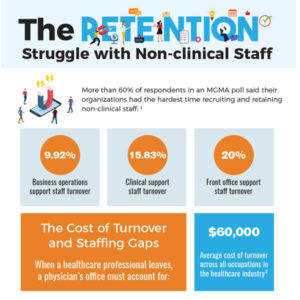Just this month, a prospective client asked me about high employee turnover. They wanted to know how we balance volume fluctuations with staff on hand since they’ve had an extremely hard time holding on to their internal billing team. This made me wonder, how do practices keep medical billing and collections under control during staffing gaps? We have technology and a bench of medical billers that focus exclusively on getting paid, but how do resource-strapped healthcare organizations that split office staff roles survive?
The Great Decline
According to the U.S. Bureau of Labor Statistics, 4 million Americans quit their jobs in July 2021. Market analysts say that healthcare’s turnover continues to increase, with 3.6% more healthcare employees quitting their jobs than in the previous year. A recent Yale study examined whether EHRs could be used to identify physicians at risk of leaving the workforce due to burnout. Patient-facing roles are no doubt at the highest risk of turnover due to extreme increases in demand from the pandemic, likely leading to increased workloads and burnout. But what about non-clinical staff? What about critical medical billing and collections teams?
The Retention Struggle with Non-clinical Staff
More than 60 percent of respondents in a recent STAT poll from the Medical Group Management Association (MGMA) said their organizations had the hardest time recruiting and retaining non-clinical staff:
- Business operations support staff turnover: 9.92%
- Clinical support staff turnover: 15.83%
- Front office support staff turnover: 20%
High turnover is most prevalent with front office staff. For many of our clients—physicians’ offices—this can be detrimental to quality care, customer service, and medical billing and collections, as the office staff is often recognized as the face of the business from pre to post visit.
The Cost of Turnover and Staffing Gaps
There are many considerations for the true cost of turnover. For example, when a healthcare professional leaves, a physician’s office must account for:
- Staffing costs: overtime payouts
- Training costs
- Staff workloads
- Accident rates
- Absenteeism
- Medical staff dissatisfaction
Industry experts estimate the average cost of turnover across all occupations in the healthcare industry is around $60,000. With turnover at an all-time high, how can you ensure you’re getting reimbursed, let alone for old accounts receivable (AR)?
Here are three little-known ways to improve medical billing and collections during staffing gaps:
- Outsource old AR that can hinder staff productivity.
If you’re understaffed, your remaining team is most likely focused on the new or highest dollar accounts receivable. Old accounts receivable—90 or more days old? Forget it. Your team barely has time to keep up with last month to current. A billing partner that focuses exclusively on old accounts receivable could be your solution. If old AR needs to be worked but your lean staff can’t manage it, consider outsourcing. - Outsource to consistently pursue payment on denied claims.
Are project plans in place for your previous inventory? Do you know what it’s worth? Find a partner that can convert data from the old system to new. Then find trends and patterns to identify billing issues. Internal teams, especially during work shortages, simply lack the capacity to pursue payment on denied claims. An outsourced partner specializes here. - Outsource to follow up on the $1M, $5M or $50M that could be sitting in your system.
A qualified partner should interface with all major revenue cycle platforms, which allows you to experience a seamless workflow between bills, the clearinghouse and payers. Beyond technology, a partner can focus exclusively on patient calls to collect old accounts receivable. Your team probably has no time to handle fluctuating collection volume, especially on accounts overdue by 90 days or more. Keep in mind that a particular method is required once an account has reached a certain age and you’ve tried multiple times. Specific processes and demand letters must go beyond the efforts of a typical biller.
Outsourcing your medical billing and collections requires due diligence to find a partner that best suits your organization. It’s important to confirm how long the billing company has been in business and check their references. You also need to know if they are overseas since this can be a deal breaker for many healthcare organizations.
First Coast Billing Group interfaces directly with hospital databases, allowing our team of professionals to submit claims in bulk on behalf of billing companies and medical practices. More than 300 providers trust FCBG with their old accounts receivable. To learn more about our services and technology, visit FirstCoastBillingGroup.com/ar.

